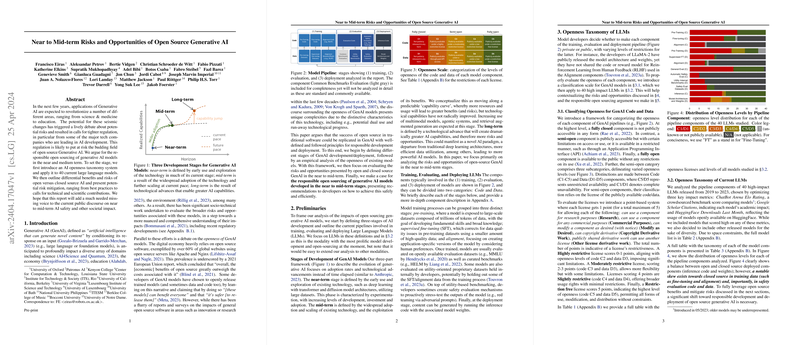Analysis of Near to Mid-term Risks and Opportunities of Open Source Generative AI
Introduction to the Study
This paper explores the nuanced domain of open sourcing generative AI (GenAI), focusing on its differential impacts over the near to mid-term phase. It begins by clarifying the stages of AI development and proceeds to provide an empirical analysis of the openness of currently available LLMs. Thereafter, it explores the contrasting risks and opportunities presented by open versus closed source AI models. Central to the paper is a compelling argument for the responsible open sourcing of GenAI models, supported by strategic recommendations for approaching this responsibly.
Modeling and Openness Taxonomy
The paper outlines a tripartite development stage for GenAI, classified into near-term, mid-term, and long-term based on technological adoption and capability rather than a fixed timeline. This categorization is pivotal for understanding the distinct operational, ethical, and societal implications at each stage. A significant portion of the analysis is devoted to assessing the current models' openness using an original taxonomy that grades components of AI systems on their openness. This evaluation brings to light a balance between open and closed components, revealing a skew towards more closed training data and safety evaluations.
Risks and Opportunities of Open Source GenAI
The discourse around open source GenAI is ripe with debates on its scalability and implications. The research highlights numerous benefits such as enhanced flexibility, customization potential, and increased transparency leading to greater public trust. However, these come alongside risks such as potential misuse by bad actors and challenges in controlling dissemination once models are publicly released. A nuanced observation provided is that while open source can facilitate innovation and economic inclusivity, it equally necessitates robust mechanisms to mitigate accompanying safety and societal risks.
Dual-Use and Security Concerns
Open source models, despite their inclusivity and potential for rapid proliferation across diverse applications, can be misappropriated to generate unsafe content or be repurposed by malevolent users. The paper emphasizes this dual-use nature as a pivotal concern needing stringent operational checks and community-led oversight to ensure responsible use.
Economic and Academic Impact
Reflections on the potential economic benefits of open source GenAI underscore its capability to democratize AI access, thereby fostering broader global participation in AI development and utilization. In academia, the open-sourcing of models catalyzes more rigorous, diverse research endeavors by providing extensive access to foundational models and datasets.
Recommendations for the Future
Strategic recommendations are presented for fostering a responsible open-source GenAI ecosystem. These include enhancing data transparency, developing robust benchmarks for open evaluation, conducting in-depth security audits, and ongoing assessment of societal impacts. Advocating for an open-source model, the paper suggests these frameworks can mitigate risks while maximizing the technology's positive impacts.
Concluding Thoughts
The paper directs a well-reasoned call towards structured open sourcing of GenAI models in the near to mid-term. By delineating both the optimistic and cautious narratives surrounding open source models, it lays a balanced viewpoint advocating for responsible and strategically planned open sourcing methodologies.
In conclusion, while the paper offers a critical roadmap for navigating the complex terrain of open source GenAI, it equally calls for sustained empirical and theoretical inquiry to adaptively manage emerging challenges and opportunities in this rapidly evolving field.
